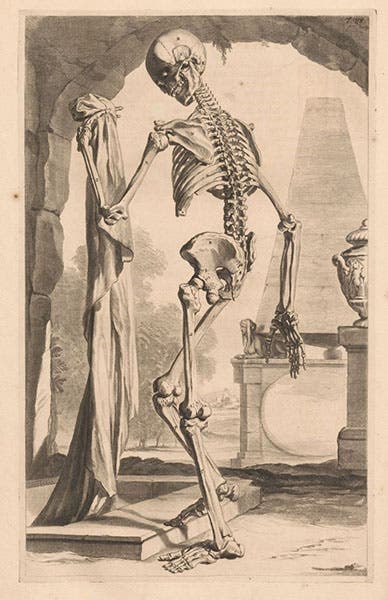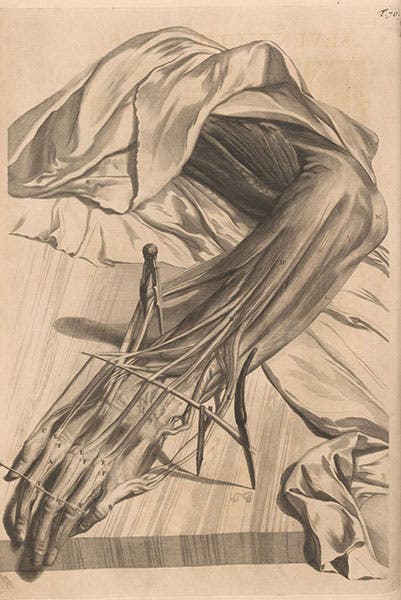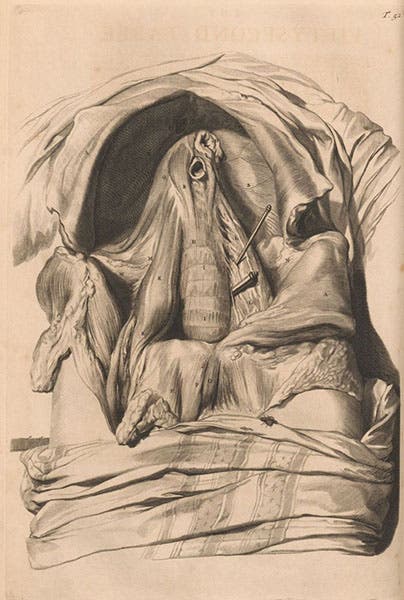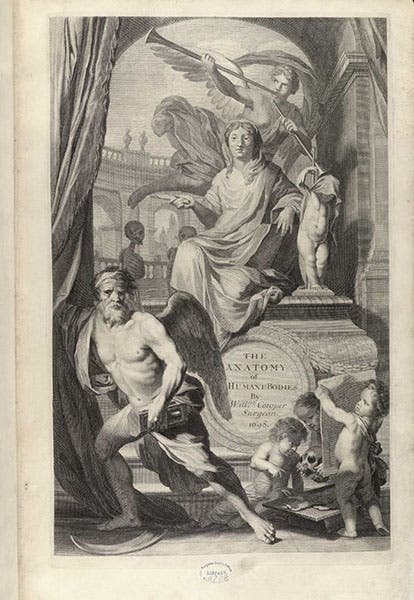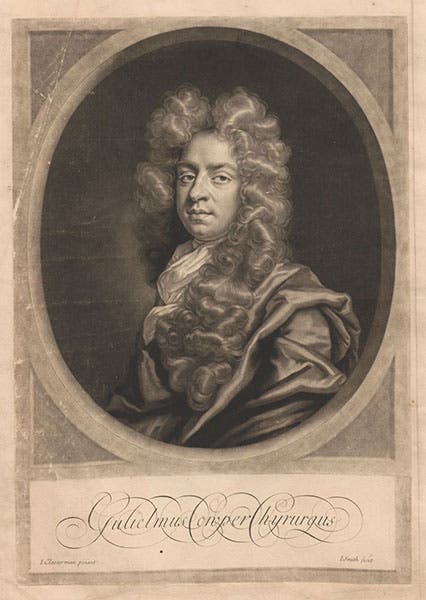Scientist of the Day - William Cowper
William Cowper, an English surgeon and anatomist, died Mar. 8, 1709, at the age of about 45. In 1698, Cowper published The Anatomy of Humane Bodies, illustrated with 114 copper plate engravings that are stunningly – almost disturbingly – realistic. The pedigree of 105 of the plates got Cowper into trouble. A Dutch anatomist, Govard Bidloo, had published his own Anatomia Humani Corporis in 1685, with plates engraved by Abraham Blooteling after drawings by Gerarde de Lairesse. Bidloo had provided very little additional text. We have published a post on Bidloo, where we included five plates from his book, which we do not have in our collections.
Bibloo’s Anatomia was reprinted in Dutch in 1690, using the same plates. Neither edition sold very well, with the result that hundreds of sets of unbound plates were just taking up room in Bidloo’s printer’s shop. So either Cowper, or his publisher (it is not clear who was the instigator) purchased the unsold prints. Cowper then wrote quite an extensive accompanying text, and issued his Anatomy with the Lairesse/Bidloo plates, his own commentary, plus nine new engravings that he commissioned from the engraver Michael van der Gucht (we include one of the new engravings as our eighth image below). The problem was that Cowper neglected to mention Bidloo or Lairesse or the source of his plates anywhere in the body of his text. And worst of all, he reused the original engraved frontispiece, which had Bidloo's name as author in a central cartouche, with a paper slip, bearing Cowper’s name and his book title, pasted over Bidloo’s name and title. We include here the entire engraved title page of Cowper’s book (sixth image), and a detail of the imprint section (seventh image), where you can just make out the irregular outline of the pasted-over slip, which says: “The Anatomy of Humane Bodies, by Will. Cowper. Surgeon. 1698.” The putto at the right might now be seen as comparing the doctored title page to the original.
Bidloo was understandably outraged at what he considered artistic theft, and he wrote letters and a pamphlet in protest, but in the absence of any copyright laws, he had no legal recourse. Cowper replied that the plates were purchased fair and square and that he did nothing wrong. Perhaps he did not, legally, but ethically, his failure to mention Bidloo or Lairess was certainly questionable behavior, at best, and at worst, outright plagiarism.
The irony is that Cowper was a very good anatomist, and an excellent anatomical artist, and could have produced his own original work (he did the magnificent drawings of a chimpanzee for Edward Tyson’s Orang-Outang (1699), which were engraved by van der Gucht; see our post on Tyson). Cowper didn't have to be the most blatant anatomical plagiarist who ever lived, as he has been often called. But the fact is, he was.
We do not have Cowper’s Anatomy in our collections, as books in human anatomy are outside our scope (the two volumes by Andreas Vesalius and Bartholomeo Eustachi being welcome exceptions). So we have drawn our images from the copy in the National Library of Medicine, which is available in its entirety online.
If you go looking for Cowper, be aware that there were quite a few people from that period with that name. Ours is the one who was born ca 1666 and died in 1709. There is a fine oil portrait of Cowper, by John Closterman, in the Hunterian Museum at the Royal College of Surgeons in London (first image). That painting, although undated, was done before 1698, because it was copied in a mezzotint and used as a frontispiece in Cowper’s Anatomy of that year (ninth image).
William B. Ashworth, Jr., Consultant for the History of Science, Linda Hall Library and Associate Professor emeritus, Department of History, University of Missouri-Kansas City. Comments or corrections are welcome; please direct to ashworthw@umkc.edu.




